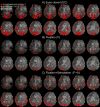Modulation of spontaneous fMRI activity in human visual cortex by behavioral state
- PMID: 19028588
- PMCID: PMC2704889
- DOI: 10.1016/j.neuroimage.2008.10.034
Modulation of spontaneous fMRI activity in human visual cortex by behavioral state
Abstract
The phenomenon of spontaneous fMRI activity is increasingly being exploited to investigate the connectivity of functional networks in human brain with high spatial-resolution. Although mounting evidence points towards a neuronal contribution to this activity, its functional role and dependence on behavioral state remain unclear. In this work, we used BOLD fMRI at 7 T to study the modulation of spontaneous activity in occipital areas by various behavioral conditions, including resting with eyes closed, eyes open with visual fixation, and eyes open with fixation and focal visual stimulation. Spontaneous activity was separated from evoked activity and from signal fluctuations related to cardiac and respiratory cycles. We found that spontaneous activity in visual areas was substantially reduced (amplitude (44%) and coherence (25%)) with the fixation conditions relative to the eyes-closed condition. No significant further modulation was observed when the visual stimulus was added. The observed dependence on behavioral condition suggests that part of spontaneous fMRI signal fluctuations represents neuronal activity. Possible mechanisms for the modulation of spontaneous activity by behavioral state are discussed. The observed linear superposition of spontaneous fMRI activity with focal evoked activity related to visual processing has important implications for fMRI studies, which ideally should take into account the effect of spontaneous activity to properly define brain activations during task conditions.
Figures






References
-
- Arieli A, Sterkin A, Grinvald A, Aertsen A. Dynamics of ongoing activity: explanation of the large variability in evoked cortical responses. Science. 1996;273:1868–1871. - PubMed
-
- Barry RJ, Clarke AR, Johnstone SJ, Magee CA, Rushby JA. EEG differences between eyes-closed and eyes-open resting conditions. Clin Neurophysiol. 2007;118:2765–2773. - PubMed
-
- Berger H. Über das Elektroenkephalogramm des Menschen. Berlin: Archiv für Psychiatrie und Nervenkrankheiten. 1929;87:527–570.
-
- Bianciardi M, Fukunaga M, van Gelderen P, Horovitz SG, de Zwart J, Duyn J. Spontaneous activity in the visual cortex persists during visual stimulation: a 7 T study; Proceedings of the 16th ISMRM Scientific Meeting; Toronto, Canada. 2008. p. 146. Book of Abstracts N. 747.
-
- Birn RM, Diamond JB, Smith MA, Bandettini PA. Separating respiratory-variation-related fluctuations from neuronal-activity-related fluctuations in fMRI. Neuroimage. 2006;31:1536–1548. - PubMed
Publication types
MeSH terms
Grants and funding
LinkOut - more resources
Full Text Sources
Other Literature Sources
Medical

